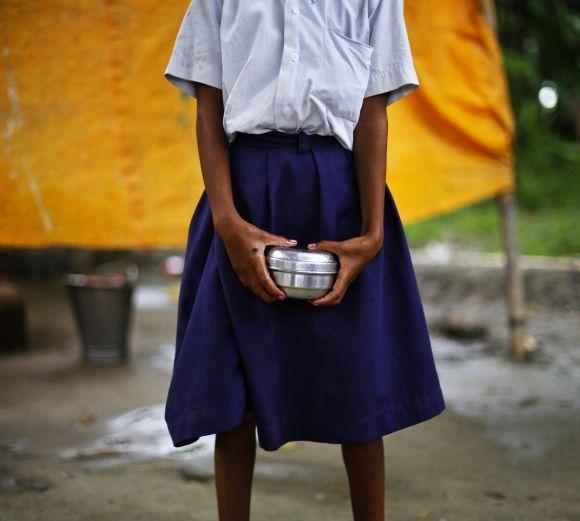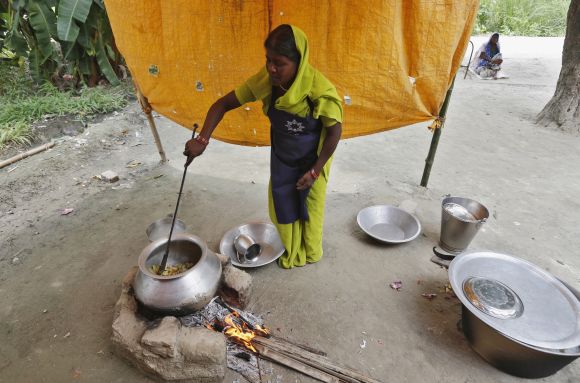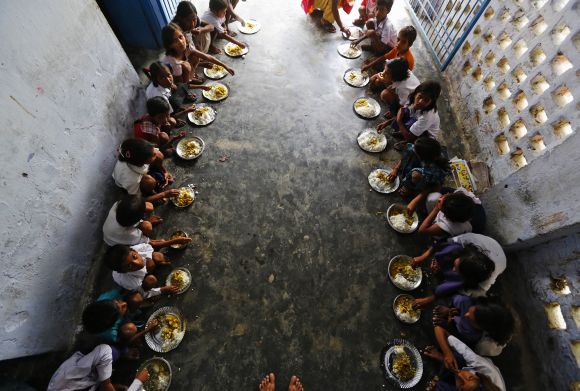
The tragedy involving the death of children in a Bihar school should reinforce recent efforts to improve the programme, notes Amarjeet Sinha.
The sad loss of 23 innocent lives after consuming hot cooked meals in a school in Bihar has rightly shocked and angered people. The highly poisonous pesticide monocrotophos found in children’s food and a headmistress overlooking the cook and the children’s protests about the oil and not tasting the food herself (as is the instruction) before serving is criminal negligence.
Further police investigation is underway to ascertain who is criminally responsible. This appears to be a case of poison in food rather than food poisoning.
It is a pity that this has happened at a time when the mid-day meal scheme in Bihar had improved a lot over the years, starting very late and with poor initial standards of implementation. Having had the meal myself in many schools, I can only say there has been a steady trend of improvement over time. This needs to continue despite this setback. This incident should reinforce rather than bring to a halt all the recent efforts to improve the programme and schooling in general in Bihar.
The writer is a civil servant. These views are personal. His recent book, An India for Everyone -- A Path to Inclusive Development (Harper Collins; 2013) discusses these issues in greater detail.
Please ...

Media coverage about the unsatisfactory state of the MDM programme in many other states as well has questioned its rationale. The media has questioned the states’ ability to manage such a programme across all elementary schools.
Evaluation studies indicate many schools do serve a good meal. Improvement is needed and must be attempted. From advocating large, hygienic kitchens like Akshay Patra, to closing the programme, to switching to food supplements in packaged form, to cash transfers, many solutions have been suggested. Some commentators have deemed it impossible to remove governance deficits and corruption.
The MDM works as a decentralised programme, funded jointly by the Central and state governments. While the food grain comes from Food Corporation of India through the state food corporations, it is the School Management Committee with the headmaster, Panchayati Raj Institutions or other community representatives, and three fourths representation of parents of children studying in that school, that is given the responsibility to buy pulses, vegetables, oil, spices, firewood, and so on as conversion cost.
Parents are seen as the greatest stakeholder and that is why the programme structure provided for the SMCs/Mothers’ Committees to have a lead role in the management and the accountability framework of the programme.
Cooks paid Rs 1,000 a month and utensils provided as part of the scheme come through programme funds. Non-governmental organisations are assigned the responsibility to run the programme in a few schools. Akshay Patra-like NGOs have also been assigned the responsibility in many states. They will begin shortly in Bihar as well.
Please ...

Is the MDM needed? Does it serve any purpose? Why not packaged food? These questions call for an answer. Depsite the reference to unsatisfactory implementation reported, studies have established the role of the MDM in increasing school attendance rates.
Government schools have the largest segment of poor children coming from underprivileged households where food security at home is an issue. The hot cooked meal, with all its limitations, does hold back children in schools in larger numbers. Studies have also indicated how many children, especially in states with a very high percentage of poor families, come hungry to school. MDM does make a difference in the lives of these children.
Why is the quality poor? First, there are many new schools that have come up in partial compliance to the Right to Education Act requirement of a school within one kilometre.
Unfortunately, many of these schools have either no or very rudimentary infrastructure. Availability of land for these schools is also an issue, forcing new schools to function in single room community halls, community verandahs or, in a few cases, even under the open sky. Where the classrooms are inadequate and land unavailable, guaranteeing MDM without a kitchen shed or store for food compromises the cooking arrangements. We must immediately tag such schools to the nearest well-endowed school till such time as adequate land and infrastructure is available for such schools.
Second, even though SMCs and Mothers’ Committees have been given the role of management, in practice, a lot depends on the headmaster and the elected PRI representatives. How to strengthen the role of parents in the SMC? Is training alone the answer? Should we co-opt vocal women members from the village, like self help group members, Mahila Samakhya members, accredited social activists, Aanganwadi (child care) workers on this committee to make the community matter more? Should we make social audit and demystified presentation of accounts on the school notice board more effective? How to make it a truly community-run programme as they are the best guarantee for quality food?
Please ...

Third, allocations for conversion costs must be market-price based with the greatest trust on the SMCs’ decision-making after adequate training. If we want accounts to be fully transparent then expenses must be based on actuals with full public disclosure. Similarly, provisions for training cooks and helpers, replacement of utensils, and so on must be as liberal as possible.
Fourth, the headmaster, cook and community representatives must mandatorily taste the food and certify its quality before it is consumed by children. This safeguard will go a very long way towards improving safety and hygiene.
Fifth, clean water, sanitation (washing hands) and hygiene needs to be systematically promoted. Schools need a higher grant for maintenance. There must be adequate untied resources at the school level to ensure a clean school with safe water and good hygiene.
Sixth, information technology-enabled systems for effective monitoring and a reliable mangement information system will go a long way in improving accountability. The Interactive Voice Record System effort in a few states for daily monitoring is indeed a step in the right direction.
Seventh, nutritionists, food regulators, programme managers need to be inducted in the programme at all levels with proper health monitoring of the children.
Eighth, food storage at the school level must receive greater attention with appropriate storage bins for all ingredients.
The hot cooked meal appears the best option for children. Packaged food is no substitute for a hot meal, if served hygienically and as a balanced diet. MDM also promotes socialisation of communities. Pulses and vegetables and a wholesome meal have the potential to improve children’s nutrition.
The Akshay Patra kind of centralised kitchen using modern scientific technology with in-built safeguards is a good option but then, it cannot become the source for all schools spread over a million habitations, villages and towns of India.
Crafting credible public systems is possible. They need to be adequately provided for with detailed last mile implementation arrangements. Let us not throw out the baby with the bathwater. Let us make the MDM work. Community management is our best hope. Their stake is the greatest.
...